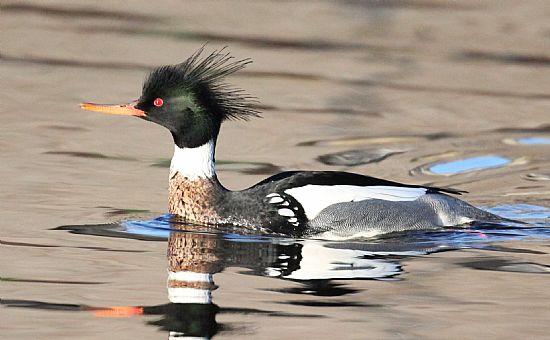Added on 14 February 2015
The Inner Moray Firth and Cromarty Firth are designated as SPAs - Special Protection Areas, this designation was confirmed on 22nd March 1999 so long established.
The Inner Moray Firth SPA is made up of four old SSSIs: Whiteness Head, Longman and Castle Stuart Bays, Munlochy Bay, and Beauly Firth, The Cromarty Firth SPA covers the existing Site of Special Scientific Interest (SSSI), extending eastward from the islands at the mouth of the river Conon to Cromarty and Nigg.
 The wintering species of particular significance in a European context are whooper swan, bar tailed godwit, greylag geese and redshank. The Firths also provide foraging grounds for breeding osprey that nest in nearby woodland, and a nationally important population of common tern.
The wintering species of particular significance in a European context are whooper swan, bar tailed godwit, greylag geese and redshank. The Firths also provide foraging grounds for breeding osprey that nest in nearby woodland, and a nationally important population of common tern.
The birds and other rich wildlife of these special areas are enjoyed by many people. By attracting visitors to the Moray firth they contribute positively to the local economy. Having become an SPA means that any proposals which might affect the birds have to be assessed very carefully by the appropriate regulatory authority, and this has been the case since the sites were first consulted over in 1997. SNH’s role in this is to advise the various regulatory authorities to help them in that process.”
Both the Cromarty Firth SPA and Inner Moray Firth SPA have also qualified as Ramsar sites, wetlands of international importance.
The Natura network includes Special Areas of Conservation (SAC), under the Habitats Directive, where they support rare, endangered or vulnerable natural habitats or species of plants or animals (other than birds); and Special Protection Areas (SPAs), under the Wild Birds Directive, where they support significant numbers of wild birds and their habitats. Some areas may become both SPA and SAC.
The term Natura 2000 comes from the 1992 EC Habitats Directive; it symbolises the conservation of precious natural resources for the year 2000 and beyond. The Habitats Directive itself stems from the 1992 Rio Earth Summit. It is a major contribution by the European Community to implementing the Biodiversity Convention agreed by more than 150 countries, and its implementation in Scotland is one of SNH’s largest tasks. The Biodiversity Convention aims to protect the variety of wildlife which exists globally by focusing on Habitats and Species.
Inner Moray Firth
SPA status Classified 22/03/1999
Latitude 56 50 25 N
Longitude 04 21 15 W
SPA EU code UK9001624
Area (ha) 2339.23
Component SSSI/ASSIs Beauly Firth
Longman & Castle Stuart Bays
Munlochy Bay
Whiteness Head
The Inner Moray Firth is located to the north of Inverness in Scotland and is one of the major arms of the Moray Firth. It comprises the Beauly Firth and Inverness Firth (including Munlochy Bay) which together form the easternmost estuarine component of the Moray Basin ecosystem. The site contains extensive intertidal flats and smaller areas of saltmarsh. The rich invertebrate fauna of the intertidal flats, with beds of eelgrass Zostera spp., GlasswortSalicornia spp., and Enteromorpha algae, all provide important food sources for large numbers of wintering and migrating waterbirds (geese, ducks and waders). With adjacent estuarine areas elsewhere in the Moray Firth, this site is the most northerly major wintering area for wildfowl and waders in Europe. The Firth is also of importance as a feeding area for locally breeding Osprey Pandion haliaetusas well as for breeding terns.
The Inner Moray Firth SPA forms an integral ecological component of Moray Basin Firths and Bays. When the SPA status was confirmed, the following bird numbers were observed.
During the breeding season;
Common Tern Sterna hirundo, 310 pairs representing at least 2.5% of the breeding population in Great Britain (Seabird Census Register)
Osprey Pandion haliaetus, 4 pairs representing at least 4.0% of the breeding population in Great Britain (Early 1990s)
Over winter;
Bar-tailed Godwit Limosa lapponica, 1,155 individuals representing at least 2.2% of the wintering population in Great Britain (winter peak mean)
The Inner Moray Firth site also qualifies under Article 4.2 of the Directive (79/409/EEC) by supporting populations of European importance of the following migratory species:
Over winter;
Greylag Goose Anser anser, 1,731 individuals representing at least 1.7% of the wintering Iceland/UK/Ireland population (winter peak mean)
Red-breasted Merganser Mergus serrator, 1,731 individuals representing at least 1.4% of the wintering Northwestern/Central Europe population (winter peak mean)
Redshank Tringa totanus, 1,811 individuals representing at least 1.2% of the wintering Eastern Atlantic - wintering population (winter peak mean)
Scaup Aythya marila, 97 individuals representing <0.1% of the wintering Northern/Western Europe population (Counts 1991-96)
Assemblage qualification: A wetland of international importance.
The area qualifies under Article 4.2 of the Directive (79/409/EEC) by regularly supporting at least 20,000 waterfowl
Over winter, the area regularly supports 33,148 individual waterfowl (5 year peak mean 1991/2 - 1995/6)
including: Scaup Aythya marila, Curlew Numenius arquata, Oystercatcher Haematopus ostralegus, Goosander Mergus merganser, Goldeneye Bucephala clangula, Teal Anas crecca, Wigeon Anas penelope, Cormorant Phalacrocorax carbo, Redshank Tringa totanus, Red-breasted Merganser Mergus serrator, Greylag Goose Anser anser, Bar-tailed GodwitLimosa lapponica.
Note:
Many designated sites are on private land: the listing of a site in these pages does not imply any right of public access.
Note that sites selected for waterbird species on the basis of their occurrence in the breeding, passage or winter periods also provide legal protection for these species when they occur at other times of the year. information taken from
http://jncc.defra.gov.uk/default.aspx?page=1879